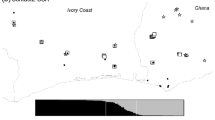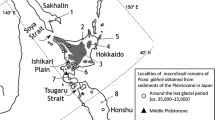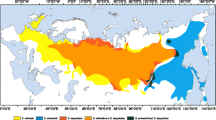Abstract
Introgression frequently occurs between closely related plant species when there is incomplete reproductive isolation. However, few studies have been designed to examine the extent and direction of introgression from all three genomes, especially when they have different rates of gene flow. Conifers, in which chloroplast (cp), mitochondrial (mt) and nuclear (nr) genomes show contrasting rates of gene flow, provide a good model in which to carry out such a case study. Here we use data on sequence variation in 18 DNAs from three genomes for 311 individuals of 31 populations to investigate the extent and direction of introgressions between three spruce species in areas where they are sympatrically distributed. We found that one species seem to have introgressions derived from the other two species in areas of sympatric distribution; there were more introgressions from the maternally inherited mtDNA, which has the lowest rate of gene flow, and fewer introgressions from the bi-parentally inherited nrDNA. Further coalescent analysis of nrDNA population genetic data suggested that the species containing introgressions had experienced range expansion in the recent past while there was no such indication for the other two species. Our results support the hypotheses that introgressions occurred more frequently at genetic markers with lower rates of gene flow and that they usually took place from local species towards invading species that had undergone recent demographic expansion.





Similar content being viewed by others
References
Arnold ML, Tang S, Knapp SJ, Martin NH (2010) Asymmetric introgressive hybridization among louisiana iris species. Genes 1:9–22
Bai WN, Liao WJ, Zhang DY (2010) Nuclear and chloroplast DNA phylogeography reveal two refuge areas with asymmetrical gene flow in a temperate walnut tree from East Asia. New Phytol 188:892–901
Bouille M, Bousquet J (2005) Trans-species shared polymorphisms at orthologous nuclear gene loci among distant species in the conifer Picea (Pinaceae): implications for the long-term maintenance of genetic diversity in trees. Amer J Bot 92:63–73
Cahill JA, Green RE, Fulton TL, Stiller M, Jay F, Ovsyanikov N, Salamzade R, St John J, Stirling I, Slatkin M, Shapiro B (2013) Genomic evidence for island population conversion resolves conflicting theories of polar bear evolution. PLOS Genet 9:e1003345
Chen J, Kallman T, Gyllenstrand N, Lascoux M (2010) New insights on the speciation history and nucleotide diversity of three boreal spruce species and a Tertiary relict. Heredity 104:3–14
Comes HP, Kadereit JW (1998) The effect of quaternary climatic changes on plant distribution and evolution. Trends Pl Sci 3:432–438
Cornuet JM, Raviqne V, Estoup A (2010) Inference on population history and model checking using DNA sequence and microsatellite data with the software DIYABC (v1. 0). BMC Bioinform 11:401
Currat M, Ruedi M, Petit RJ, Excoffier L (2008) The hidden side of invasions: massive introgression by local genes. Evolution 62:1908–1920
Du FK, Petit RJ, Liu JQ (2009) More introgression with less gene flow: chloroplast vs. mitochondrial DNA in the Picea asperata complex in China, and comparison with other conifers. Molec Ecol 18:1396–1407
Du FK, Peng XL, Liu JQ, Lascoux M, Hu FS, Petit RJ (2011) Direction and extent of organelle DNA introgression between two spruce species in the Qinghai-Tibetan Plateau. New Phytol 192:1024–1033
Duvaux L, Belkhir K, Boulesteix M, Boursot P (2011) Isolation and gene flow: inferring the speciation history of European house mice. Molec Ecol 20:5248–5264
Evanno G, Regnaut S, Goudet J (2005) Detecting the number of clusters of individuals using the software structure: a simulation study. Molec Ecol 14:2611–2620
Excoffier L, Laval G, Schneider S (2005) Arlequin ver. 3.0: an integrated software package for population genetics data analysis. Evol Bioinf 1:47–50
Fay JC, Wu CI (2000) Hitchhiking under positive darwinian selection. Genetics 155:1405–1413
Fitzpatrick BM, Johnson JR, Kump DK, Shaffer HB, Smith JJ, Voss SR (2009) Rapid fixation of non-native alleles revealed by genome-wide SNP analysis of hybrid tiger salamanders. BMC Evol Biol 9:176
Fu YX, Li WH (1993) Statistical tests of neutrality of mutations. Genetics 133:693–709
Fu L, Li N, Mill RR (1999) Pinaceae. In: Wu ZY, Raven PH (eds) Flora of China, Science Press, Beijing, pp 11–52
Gay L, Neubauer G, Zagalska-Neubauer M, Debain C, Pons JM, David P, Crochet PA (2007) Molecular and morphological patterns of introgression between two large white-headed gull species in a zone of recent secondary contact. Molec Ecol 16:3215–3227
Green RE, Krause J, Briggs AW, Maricic T, Stenzel U, Kircher M, Patterson N, Li H, Zhai W, Fritz MH, Hansen NF, Durand EY, Malaspinas AS, Jensen JD, Marques-Bonet T, Alkan C, Prufer K, Meyer M, Burbano HA, Good JM, Schultz R, Aximu-Petri A, Butthof A, Hober B, Hoffner B, Siegemund M, Weihmann A, Nusbaum C, Lander ES, Russ C, Novod N, Affourtit J, Egholm M, Verna C, Rudan P, Brajkovic D, Kucan Z, Gusic I, Doronichev VB, Golovanova LV, Lalueza-Fox C, de la Rasilla M, Fortea J, Rosas A, Schmitz RW, Johnson PL, Eichler EE, Falush D, Birney E, Mullikin JC, Slatkin M, Nielsen R, Kelso J, Lachmann M, Reich D, Paabo S (2010) A draft sequence of the Neandertal genome. Science 328:710–722
Heuertz M, Paoli ED, Kallman T, Larsson H, Jurman I, Morgante M, Lascoux M, Gyllenstrand N (2006) Multilocus patterns of nucleotide diversity, linkage disequilibrium and demographic history of Norway spruce [Picea abies (L.) Karst]. Genetics 174:2095–2105
Hewitt GM (1996) Some genetic consequences of ice ages, and their role in divergence and speciation. Biol J Linn Soc 58:247–276
Hey J (2010) Isolation with migration models for more than two populations. Molec Biol Evol 27:905–920
Hubisz MJ, Falush D, Stephens M, Pritchard JK (2009) Inferring weak population structure with the assistance of sample group information. Molec Ecol Resources 9:1322–1332
Jarvis DI, Hodgkin T (1999) Wild relatives and crop cultivars: detecting natural introgression and farmer selection of new genetic combinations in agroecosystems. Molec Ecol 8:159–173
Lepais O, Petit RJ, Guichoux E, Lavabre JE, Alberto F, Kremer A, Gerber S (2009) Species relative abundance and direction of introgression in oaks. Molec Ecol 18:2228–2242
Li Y, Stocks M, Hemmila S, Kallman T, Zhu HT, Zhou YF, Chen J, Liu JQ, Lascoux M (2010) Demographic histories of four spruce (Picea) species of the Qinghai-Tibetan Plateau and neighboring areas inferred from multiple nuclear loci. Molec Biol Evol 27:1001–1014
Librado P, Rozas J (2009) DnaSP v5: a software for comprehensive analysis of DNA polymorphism data. Bioinformatics 25:1451–1452
Lockwood JD, Aleksic JM, Zou JB, Wang J, Liu JQ, Renner SS (2013) A new phylogeny for the genus Picea from plastid, mitochondrial, and nuclear sequences. Molec Phylogen Evol 69:717–727
Martin NH, Willis JH (2007) Ecological divergence associated with mating system causes nearly complete reproductive isolation between sympatric Mimulus species. Evolution 61:68–82
McGuire JA, Linkem CW, Koo MS, Hutchison DW, Lappin AK, Orange DI, Lemos-Espinal J, Riddle BR, Jaeger JR (2007) Mitochondrial introgression and incomplete lineage sorting through space and time: phylogenetics of crotaphytid lizards. Evolution 61:2879–2897
Melo-Ferreira J, Boursot P, Suchentrunk F, Ferrand N, Alves PC (2005) Invasion from the cold past: extensive introgression of mountain hare (Lepus timidus) mitochondrial DNA into three other hare species in northern Iberia. Molec Ecol 14:2459–2464
Mogensen HL (1996) The hows and whys of cytoplasmic inheritance in seed plants. Amer J Bot 83:383–404
Neafsey DE, Lawniczak MK, Park DJ, Redmond SN, Coulibaly MB, Traore SF, Sagnon N, Costantini C, Johnson C, Wiegand RC, Collins FH, Lander ES, Wirth DF, Kafatos FC, Besansky NJ, Christophides GK, Muskavitch MA (2010) SNP genotyping defines complex gene-flow boundaries among African malaria vector mosquitoes. Science 330:514–517
Neale DB, Sederoff RR (1988) Inheritance and evolution of conifer organelle genomes. In: Hanover JW, Keathley DE (eds) Genetic manipulation of woody plants. Springer, US, pp 251–264
Nei M (1987) Molecular evolutionary genetics. Columbia University Press, New York
Petit RJ, Hampe A (2006) Some evolutionary consequences of being a tree. Annual Rev Ecol Evol Syst 37:187–214
Petit RJ, Vendramin GG (2007) Plant phylogeography based on organelle genes: an introduction. In: Weiss S, Ferrand N (eds) Phylogeography of southern European refugia, Springer, Netherlands, pp 23–97
Petit RJ, Bodénès C, Ducousso A, Roussel G, Kremer A (2004) Hybridization as a mechanism of invasion in oaks. New Phytol 161:151–164
Pritchard JK, Stephens M, Donnelly P (2000) Inference of population structure using multilocus genotype data. Genetics 155:945–959
Ran JH, Wei XX, Wang XQ (2006) Molecular phylogeny and biogeography of Picea (Pinaceae): implications for phylogeographical studies using cytoplasmic haplotypes. Molec Phylogen Evol 41:405–419
Rhymer JM, Simberloff D (1996) Extinction by hybridization and introgression. Annual Rev Ecol Syst 27:83–109
Rieseberg LH, Kim SC, Randell RA, Whitney KD, Gross BL, Lexer C, Clay K (2007) Hybridization and the colonization of novel habitats by annual sunflowers. Genetica 129:149–165
Rosenberg NA (2004) Distruct: a program for the graphical display of population structure. Molec Ecol Notes 4:137–138
Song Y, Endepols S, Klemann N, Richter D, Matuschka FR, Shih CH, Nachman MW, Kohn MH (2011) Adaptive introgression of anticoagulant rodent poison resistance by hybridization between old world mice. Curr Biol 21:1296–1301
Tajima F (1989) Statistical method for testing the neutral mutation hypothesis by DNA polymorphism. Genetics 123:585–595
Teeter KC, Thibodeau LM, Gompert Z, Buerkle CA, Nachman MW, Tucker PK (2010) The variable genomic architecture of isolation between hybridizing species of house mice. Evolution 64:472–485
Watterson GA (1975) On the number of segregating sites in genetical models without recombination. Theor Populat Biol 7:256–276
Weir BS, Cockerham CC (1984) Estimating f-statistics for the analysis of population structure. Evolution 38:1358–1370
Whitney KD, Randell RA, Rieseberg LH (2006) Adaptive introgression of herbivore resistance traits in the weedy sunflower Helianthus annuus. Amer Naturalist 167:794–807
Willyard A, Cronn R, Liston A (2009) Reticulate evolution and incomplete lineage sorting among the ponderosa pines. Molec Phylogen Evol 52:498–511
Wu CY (1987) Vegetation of China. China Science Press, Beijing
Zeng K, Fu YX, Shi S, Wu CI (2006) Statistical tests for detecting positive selection by utilizing high-frequency variants. Genetics 174:1431–1439
Zhang DY (2014) Demographic model of admixture predicts symmetric introgression when a species expands into the range of another: a comment on Currat et al. (2008). J Syst Evol 52:35–39
Zhang Q, Chiang TY, George M, Liu JQ, Abbott RJ (2005) Phylogeography of the Qinghai-Tibetan Plateau endemic Juniperus przewalskii (Cupressaceae) inferred from chloroplast DNA sequence variation. Molec Ecol 14:3513–3524
Zhou YF, Abbott RJ, Jiang ZY, Du FK, Milne RI, Liu JQ (2010) Gene flow and species delimitation: a case study of two pine species with overlapping distributions in southeast China. Evolution 64:2342–2352
Zielinski P, Nadachowska-Brzyska K, Wielstra B, Szkotak R, Covaciu-Marcov SD, Cogalniceanu D, Babik W (2013) No evidence for nuclear introgression despite complete mtDNA replacement in the Carpathian newt (Lissotriton montandoni). Molec Ecol 22:1884–1903
Zou JB, Sun YS, Li L, Wang GN, Yue W, Lu ZQ, Wang Q, Liu JQ (2013) Population genetic evidence for speciation pattern and gene flow between Picea wilsonii, P. morrisonicola and P. neoveitchii. Ann Bot (Oxford) 112:1829–1844
Acknowledgments
We thank Lili Li for her help with experimental work. This research was supported by Grants from National Natural Science Foundation of China (30930072) and the Fundamental Research Funds for the Central Universities (lzujbky-2009-k05) and the International Collaboration 111 Projects of China.
Author information
Authors and Affiliations
Corresponding author
Ethics declarations
Conflict of interest
The authors declare that they have no conflict of interest.
Additional information
Handling editor: Zhu Xiang-Yun.
Electronic supplementary material
Below is the link to the electronic supplementary material.
Information on Electronic Supplementary Material
Information on Electronic Supplementary Material
Online Resource 1. The distribution of sampling localities for Picea meyeri, P. wilsonii and P. neoveitchii.
Online Resource 2. Sampling sites. The location and number of samples for P. wilsonii, P. neoveitchii and P. meyeri
Online Resource 3. Alignments used to produce phylogenetic relationships (4 cl)
Online Resource 4. Alignments used to produce phylogenetic relationships (EBS)
Online Resource 5. Alignments used to produce phylogenetic relationships (FT3)
Online Resource 6. Alignments used to produce phylogenetic relationships (GI)
Online Resource 7. Alignments used to produce phylogenetic relationships (M002)
Online Resource 8. Alignments used to produce phylogenetic relationships (M007D1)
Online Resource 9. Alignments used to produce phylogenetic relationships (PCH)
Online Resource 10. Alignments used to produce phylogenetic relationships (Sb16)
Online Resource 11. Alignments used to produce phylogenetic relationships (Sb29)
Online Resource 12. Alignments used to produce phylogenetic relationships (Sb62)
Online Resource 13. Alignments used to produce phylogenetic relationships (Se1364 )
Online Resource 14. Alignments used to produce phylogenetic relationships (Se1390)
Online Resource 15. Alignments used to produce phylogenetic relationships (xy1420)
Online Resource 16. Alignments used to produce phylogenetic relationships (cpDNA)
Online Resource 17. Alignments used to produce phylogenetic relationships (mtDNA)
Online Resource 18. Descriptions of prior settings for all parameters used in DIYABC
Online Resource 19. Variable sites of aligned sequences of three cpDNA fragments from which eleven chlorotypes were identified
Online Resource 20. Estimates of average gene diversity within populations (H S), total gene diversity (H T), interpopulation differentiation (G ST) and number of substitution types (N ST)
Online Resource 21. Variable sites of aligned sequences of two mtDNA fragments from which ten mitotypes were identified
Online Resource 22. Analysis of molecular variance (AMOVA) of cpDNA and mtDNA for three species
Online Resource 23. Nucleotide variation, haplotype diversity and neutrality tests for P. wilsonii across all loci
Online Resource 24. Nucleotide variation, haplotype diversity and neutrality tests for P. neoveitchii across all loci
Online Resource 25. Nucleotide variation, haplotype diversity and neutrality tests for P. meyeri across all loci
Online Resource 26. r 2 values at each nuclear locus as measured by DnaSP to analyze the linkage disequilibrium
Online Resource 27. Genetic divergence at thirteen nuclear loci among species based on pairwise comparisons: (a) P. wilsonii (b) P. neoveitchii and (c) P. meyeri
Online Resource 28. Estimated the most likely number of clusters (K) obtained with Structure using the distribution of DeltaK (ΔK), the posterior probability of the data given each K, for K 1–6. Each K is represented by 10 separate runs. Variation among runs was limited
Online Resource 29. Posterior probabilities of five competing scenarios for each species
Online Resource 30. Histories for two species pairs (for sampled and ancestral populations) represented as boxes
Online Resource 31. Genetic divergence based on analysis of molecular variance (AMOVA) of cpDNA and mtDNA between three species
Online Resource 32. Genetic divergence at three genomes between species based on pairwise comparisons: (a) P. wilsonii (b) P. neoveitchii and (c) P. meyeri
Rights and permissions
About this article
Cite this article
Wang, X., Lu, J., Yue, W. et al. Determining the extent and direction of introgression between three spruce species based on molecular markers from three genomes with different rates of gene flow. Plant Syst Evol 302, 691–701 (2016). https://doi.org/10.1007/s00606-016-1289-3
Received:
Accepted:
Published:
Issue Date:
DOI: https://doi.org/10.1007/s00606-016-1289-3




